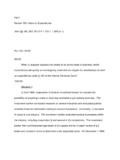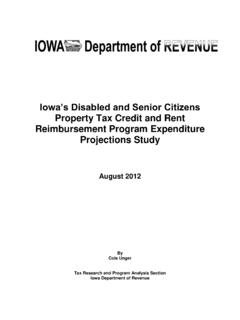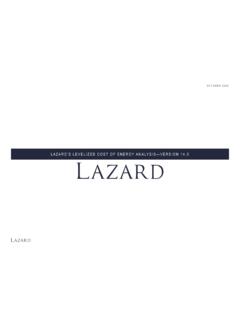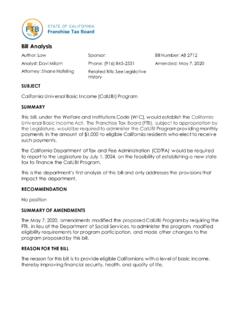Transcription of IN THIS SECTION The complexity and flexibility
1 2020 essential tax and wealth planning guide | Part 2 15 WELCOMETA X POLIC YWEALTH TRANSFERINTEREST TRACINGLOSSESRESOURCESThe complexity and flexibility of interest tracingA brief historyApplying the rulesA basic exampleWith flexibility , timing is keyNew business interest expense implicationsAssess your situation to arrive at a favorable resultIN THIS SECTIONINTEREST TRACINGThe complexity and flexibility of interest tracingWhen a taxpayer borrows funds, a common misconception is that the deductibility of interest expense is determined by how the loan is collateralized. That is not the case. In fact, the deductibility of interest expense is determined based on how the loan proceeds are used, otherwise referred to as interest tracing. Over time, interest tracing has evolved into one of the more complex facets of the Internal Revenue Code. The rules for interest tracing appear rather elegant and simple in their application when you consider that the character of the interest expense paid is determined merely based on how the borrowed funds were used.
2 However, adding to the complexity of these rules is that interest tracing is an ongoing analysis that must be continually revisited, not simply determined based on how the funds were initially used. For example, what happens when the asset acquired with the borrowed funds is ultimately sold? After borrowed funds are redeployed, the subsequent use of the borrowed funds, not the original use, will determine the character of the interest expense the enactment of the TCJA and the rules that now place further limitations on the deductibility of interest expense incurred to fund a trade or business, many taxpayers are now revisiting this issue and recognizing the overall complexity of the interest tracing rules. As part of that endeavor, it is helpful to have a better understanding of how the interest tracing rules work. Interest tracing is an ongoing analysis that must be continually revisited, not simply determined based on how the borrowed funds were initially used.
3 2020 essential tax and wealth planning guide | Part 2 16 WELCOMETA X POLIC YWEALTH TRANSFERINTEREST TRACINGLOSSESRESOURCESThe complexity and flexibility of interest tracingA brief historyApplying the rulesA basic exampleWith flexibility , timing is keyNew business interest expense implicationsAssess your situation to arrive at a favorable resultIN THIS SECTIONINTEREST TRACINGA brief historyPersonal interest Investment interestResidential interestPassive interestRelated to credit card debt, auto loans, and other household borrowingRelated to property held for investment (for example, stocks, mutual funds, land, and other investments); however, interest incurred to produce tax-exempt income is not deductibleMortgage interest on a primary and/or secondary homeIncludes interest on debt for business or other income-producing activities in which the taxpayer does not materially participateIncludes interest on debt for activities in which the taxpayer materially participatesTrade or business interestPrior to the Tax Reform Act of 1986 (1986 TRA), interest expense, regardless of type, was generally deductible.
4 The 1986 TRA made personal interest, other than qualified residence interest, nondeductible and limited deductions for other types of interest expense. Shortly thereafter, guidance was issued that introduced interest tracing. As mentioned above, the interest tracing rules determine the character of interest expense by tracing the use of the loan proceeds to specific asset acquisitions or expenditures. These rules place the emphasis on the loan s use, rather than on the underlying asset used to collateralize the loan. The various categories of interest expense are as follows: 2020 essential tax and wealth planning guide | Part 2 17 WELCOMETA X POLIC YWEALTH TRANSFERINTEREST TRACINGLOSSESRESOURCESThe complexity and flexibility of interest tracingA brief historyApplying the rulesA basic exampleWith flexibility , timing is keyNew business interest expense implicationsAssess your situation to arrive at a favorable resultIN THIS SECTIONINTEREST TRACINGA pplying the rulesWith that as background, how would you apply the interest tracing rules?
5 As an example, assume a taxpayer borrowed from a bank and used the loan proceeds to purchase a boat. Assume that the loan was secured by an investment account held with the bank. It may feel intuitive to determine the deductibility of the interest expense based on how the loan is secured. Under that approach, the interest expense would be characterized as investment interest expense due to the loan being secured by investment assets. However, as we learned earlier, the interest tracing rules stipulate that, to determine the character of the interest expense, a taxpayer must trace how the loan proceeds were used. Since the loan proceeds were used to purchase a boat, which in this case is a personal asset, the interest expense should be categorized as personal, and therefore , consider what happens when the proceeds are redeployed. Assume that at some time in the future the taxpayer decides to sell the boat and then use the proceeds from the sale of the boat to purchase inventory for their sole proprietorship.
6 The interest expense on the loan is now subsequently traced to a business expense and thus the character of the interest expense changes from personal to trade or business. Note that this does not retroactively affect the interest expense incurred while the proceeds were traced to the acquisition of the boat. As such, the taxpayer has personal interest expense until the boat is sold and business interest expense once the proceeds from the sale of the boat are used for the taxpayer s s now take a step back and add some more complexity to our scenario. Assume that before our taxpayer purchased their boat, the loan proceeds were first deposited into an investment bank account rather than being immediately disbursed to purchase the boat. How would our result change? The interest tracing rules determine that a deposit of loan proceeds into an account is treated as an investment expenditure and amounts held in an account (whether or not the account is interest-bearing) are treated as property held for investment.
7 What that tells us is that upon the deposit of the loan proceeds into our taxpayer s bank account, the interest expense incurred would be characterized as investment interest expense. Recall that the interest tracing rules require the debt to be reallocated whenever the proceeds are used for another expenditure . Therefore, our taxpayer would have investment interest expense upon the deposit of the loan proceeds into their bank account, which would be recharacterized as personal interest expense upon the use of the loan proceeds to purchase their boat, then further recharacterized as trade or business interest expense upon using the sales proceeds from the boat to purchase inventory for their sole proprietorship. 2020 essential tax and wealth planning guide | Part 2 18 WELCOMETA X POLIC YWEALTH TRANSFERINTEREST TRACINGLOSSESRESOURCESThe complexity and flexibility of interest tracingA brief historyApplying the rulesA basic exampleWith flexibility , timing is keyNew business interest expense implicationsAssess your situation to arrive at a favorable resultIN THIS SECTIONINTEREST TRACINGA basic exampleLet s explore interest tracing further with another example.
8 Assume a taxpayer borrows $100,000 on January 1 and immediately uses the proceeds to open a non-interest-bearing checking account. No other amounts are deposited in the account during the year, and no portion of the principal amount of the debt is repaid during the year. On April 1, the taxpayer uses $20,000 of the debt proceeds held in the account to purchase a boat. On September 1, the taxpayer sells the boat and uses the $20,000 of proceeds from the sale of the boat to purchase inventory for their business. The result of this activity is shown to the entire $100,000 of debt is treated as an investment expenditure because the entire amount of loan proceeds is held in an investment account. $20,000 of debt is allocated to a personal expenditure , since $20,000 of the loan has been used to buy a boat, but the remaining $80,000 remains allocated to an investment expenditure , since that amount remains in an investment account.$20,000 of debt is now allocated to a trade or business, since the personal asset was sold, with the sales proceeds being used to fund the taxpayer s business, and $80,000 remains allocated to an investment expenditure , as that amount remains in an investment 1 APR 1 FEBMAR 31 AUG 31 MAY JUNJULSEP 1 OCTNOV DEC 31 2020 essential tax and wealth planning guide | Part 2 19 WELCOMETA X POLIC YWEALTH TRANSFERINTEREST TRACINGLOSSESRESOURCESThe complexity and flexibility of interest tracingA brief historyApplying the rulesA basic exampleWith flexibility , timing is keyNew business interest expense implicationsAssess your situation to arrive at a favorable resultIN THIS SECTIONINTEREST TRACINGWith flexibility .
9 Timing is keyAnother factor in the interest tracing rules is that a taxpayer may treat any expenditure made from an account within 30 days before or 30 days after debt proceeds are deposited in that account as being made from those loan proceeds. As an example, suppose a taxpayer spends $10,000 from an account to acquire a publicly traded stock investment. Ten days later, the taxpayer deposits loan proceeds into the same account. This rule allows the taxpayer to treat the acquisition of their stock investment as being made from the loan proceeds and thus trace the interest expense as investment interest expense. The 30-day rule provides flexibility to taxpayers to analyze the impact of the interest tracing rules; timing is the key. While we have only reviewed a few scenarios, we hope it is apparent that the interest tracing rules, while quite complex in their application, also provide significant flexibility that can be beneficial to taxpayers.
10 This flexibility provides an opportunity for planning. By anticipating borrowing needs and identifying asset acquisitions or expenses that can yield an interest expense deduction if funded with loan proceeds, a taxpayer can determine what steps they need to take to improve their tax anticipating borrowing needs and identifying asset acquisitions or expenses that can yield an interest expense deduction if funded with loan proceeds, a taxpayer can determine what steps they need to take to improve their tax posture. 2020 essential tax and wealth planning guide | Part 2 20 WELCOMETA X POLIC YWEALTH TRANSFERINTEREST TRACINGLOSSESRESOURCESThe complexity and flexibility of interest tracingA brief historyApplying the rulesA basic exampleWith flexibility , timing is keyNew business interest expense implicationsAssess your situation to arrive at a favorable resultIN THIS SECTIONINTEREST TRACINGWith flexibility , timing is keyIt is important to note that debt incurred by a taxpayer to acquire an interest in a passthrough entity or debt incurred by a passthrough entity to fund distributions to its owners adds an additional layer of complexity that is beyond the scope of this article.














